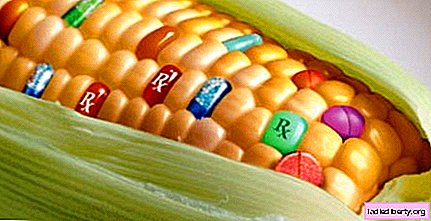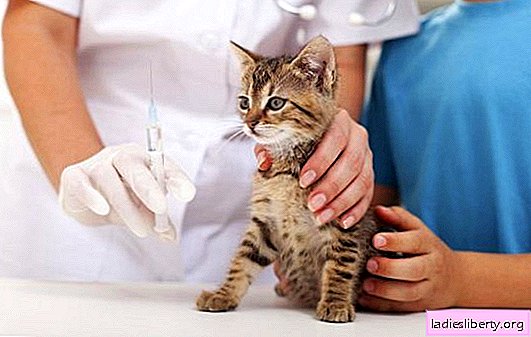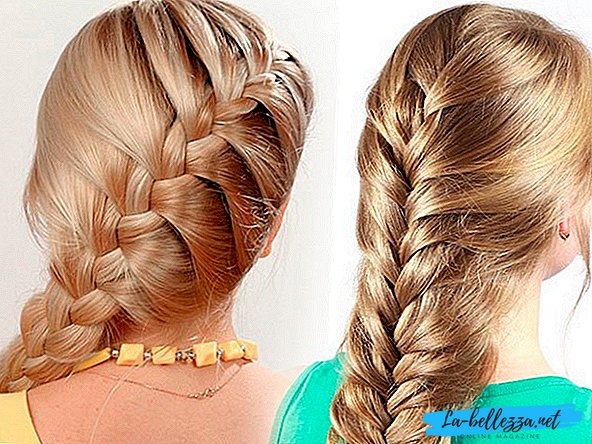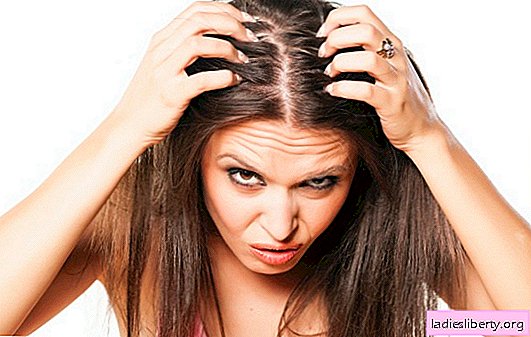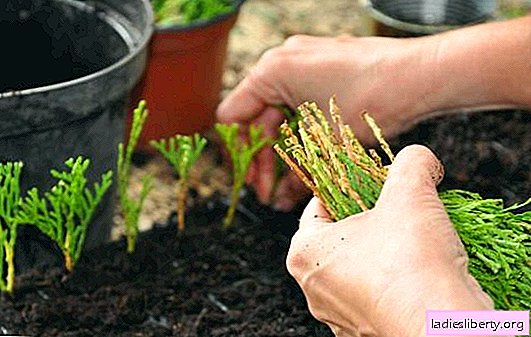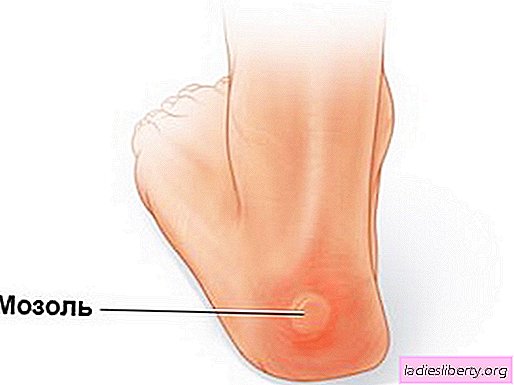
"Donnerwetter, what a pain! On a favorite callus!" The exclamation of Yashka the artilleryman from the once popular comedy comedy that sounded during the dance will cause a smile of recognition to many. Indeed, this is a very common and very painful problem. Unpleasant sensations, lame walk - all these are signs that corns appeared on the legs. Where do they come from, what are they and how to cure a blister in the end? There are a lot of questions, but the answers to them are quite simple.
How are calluses on the legs
The blame for the appearance of extraneous formations on the feet almost entirely lies on the uncomfortable and cramped shoes. Due to prolonged friction and pressure, skin thickening is formed. Actually, the same sad result will be in the event that the shoes are too loose. Especially fast is the callus on the foot of a person who has to walk for a long time.
Another provoking factor is excessive mass. Obesity - the cause of increasing the load on the legs, increasing friction.
Doctors have identified a predisposition to the formation of corns on the soles of those who are ill with vitamin deficiency (not enough vitamin A, it is poorly absorbed by the body), diabetes. Often, various fungal diseases, psoriasis, orthopedic diseases (for example, flat feet) threaten with troubles.
Problems can occur with frequent walking barefoot.
Corns on the feet: the types and their consequences
There are two main types of unpleasant illness - dry corn and wet corn. In addition, they also call bone and natoptysh. The reasons for the appearance of all these types are, in fact, the same. The main differences are in the way of education, in the individual nuances of treatment.
Corns are not contagious, they are not transmitted even by direct contact with a sick person. And even more so by airborne droplets.
The main consequence is the inability to walk in the usual step, very painful sensations. In addition, there is a danger of an inflammatory process and infection in microcracks on the corn.
Dry calluses on the feet
Externally, dry corns on the legs are easily diagnosed by a coarsened structure. They protrude above the surface of the skin, usually looking like a round yellowish spot. When pressing the pain is most often felt, a little less painless.
With prolonged exposure to a certain area of skin on it, the cells of the upper layer of the epidermis begin to die off. Due to the pressure part of the cover is compacted, increases in thickness, and does not grow outwards, but inwards. Callus on the foot has a rod that passes through all layers, and when wearing uncomfortable shoes, it presses on the nerve endings, causing rather painful sensations.
Dry corns may appear on toes, heels, soles. The most frequent places of occurrence are protruding parts of the foot, for example, bone growths.
Due to tight shoes or shoes, the blood circulation in the legs is disturbed, there is constant pressure on the skin. During the warm season, perspiration increases, and therefore friction becomes more intense. The fingers are most affected by this (skin folds between them).
Wearing sandals or stiletto heels leads to an increase in pressure on the front of the foot. As a result, dry calluses appear on the foot pads in the area around them.
Low heel on the shoe, on the contrary, causes a load on the back of the foot, resulting in a callus on the heel.
If a person puts on socks, and they form folds, then growths are able to appear in places of greatest friction and pressure, that is exactly where the fabric is wrapped and prevents to walk normally.
Callus on the legs
As a result of prolonged pressure on the skin, redness first occurs, then a blister may form, inside of which there is a lymph. The task of accumulating fluid is to protect the damaged epidermis so that it can recover (heal). If on the affected area the capillaries are located very close to the surface, and the pressure on them was quite significant, then the lymph may contain blood patches. In this case, we are talking about the so-called blood corns on the feet.
There is a problem due to wearing a narrow, tight shoe that is unsuitable in size. The skin is rubbed with too small, or, on the contrary, with too big shoes, boots, etc. A fairly rigid backdrop, rough seams, poor-quality material almost instantly lead to the appearance of blisters. Textured scars on the toes, holes in the pantyhose can also cause the formation of soft calluses on the legs. If the heel is too low or high, then due to the increasing pressure on the front of the foot and the fingers on them, blisters can develop.
They are fraught with not only pain - after the rupture of the shell, with insufficient healing of the skin under it, the lymph flows out, and free access is opened to infect the wound.
When deciding how to cure a wet callus, it is best to change your shoes to a more comfortable one at the very first signs of redness, and put a bactericidal plaster on the affected area. If no timely measures were taken, then in order to avoid further complications, it is necessary to promptly treat the affected place.
Corn on the heel
When wearing uncomfortable models with a rigid back, a callus on the heels forms:
1. dry (keratinized epithelium);
2. wet (bladder with lymph);
3. with stem (similar in symptoms to plantar wart).
The callus on the heel is determined by the following consistently sensed signs:
- redness of the skin;
- burning at the place of pressure;
- gradual loss of sensitivity of the upper, coarsening layer.
Corn on the sole
Corn on the sole is the so-called natoptysh, consisting of the layering of dead epidermis cells. The appearance is caused by frequent and prolonged pressure that interferes with blood circulation in the affected part of the leg. That it provokes keratinization of the skin.
The most susceptible to the formation of corns pillow and the base of the fingers. The first symptoms are increased burning, followed by soreness. Factors provocateurs - uncomfortable shoe, excessively high or low heel, obesity, heavy loads on the legs.
Corn on the toe
The most prone to torment from the callus on the toe of the fair sex. The desire to look spectacular makes the ladies wear tight, narrow shoes, models with long noses. The result is a deformation of the feet, coarsening of the skin.
Here it is important to learn in time how to cure a blister, and start getting rid of corns, because in neglected cases, recovery is much more difficult and takes more time, creating additional inconveniences. In the absence of treatment or its lateness there can be quite serious complications due to possible infection.
How to get rid of corns on the legs
Ways to get rid of an unpleasant problem depend on the type of callus on the legs, as well as the location of the affected area.
Dry Callus Treatment
First of all, it is necessary to eliminate the cause of the inconvenience: eliminate narrow-nosed, coarse shoes, pick up her size feet, made of quality material.
For corns on the sole, you can use soft pads to eliminate friction. They are easy to prepare yourself, making no special skills - it is enough to take a piece of soft, pleasant to the touch matter and cut a circle out of it. This pad should be placed on the corns on the feet before putting on the shoes. So that it does not slide, you should fasten it with a strip of plaster. Good help in terms of eliminating inconvenience orthopedic insoles.
For those who do not want to mess around on their own, you can purchase special covers for the fingers, which are made of soft plastic, felt.
If necessary, treatment is required to consult a specialist for examination of the problem site. Consultation is especially important if there are diseases that cause the appearance of corns on the sole, for example, the patient has diabetes or peripheral neuropathy, and has certain circulatory disorders.
How to get rid of corns on the legs at home? To do this, use products containing salicylic acid, applying them with great care to exclude contact with the area adjacent to the sore spot, make steam baths, then using pumice stone to remove the coarse surface layer.
Such a method as cutting corn on the heel is strictly not recommended at home. For such an operation is required to contact a surgeon. If it turns out that the problem cannot be solved due to the specific features of the bone structure, then the formation is promptly removed.
In general, the procedure is safe. In rare cases, complications can occur:
- blisters;
- inflammation at the surgical site (between the skin and the bone);
- skin ulcer;
- pain when putting on shoes, walking;
- the introduction of articular infections in the wound;
- infection of the bone.
Naturally, some time can be observed involuntary change in posture due to attempts to eliminate unpleasant feelings when moving on foot.
Soft callus treatment
Open blister can not be formed, because it protects damaged skin. It is better to protect a soft callus from injury with a special bactericidal plaster capable of passing air.
The bubble is treated with antiseptic agents and allowed to gradually dry.
If a soft callus on the heel is still exposed, then apply an ointment on it, which includes an antibiotic. From above, if there is no bactericidal plaster, put a piece of bandage folded in several layers and fix it with the most usual plaster. At the end of the day, when it is no longer necessary to go anywhere, it is better to remove all protective equipment, since with the access of air a clean wound will heal much faster.
The surgeon is approached most often when symptoms of infection are observed in a soft callus on the toe and heel:
- swelling and very strong redness around the problem area;
- sharp, penetrating pain, even if you do not press on the bubble;
- clouding of the fluid inside;
- discharge of pus;
- temperature increase of the place where the corn is located.
At home, a variety of baths are usually used to heal corns on the soles.
1. From the decoction of chamomile or calendula. They have amazing anti-inflammatory, wound-healing properties. Also, the procedure has an antibacterial, drying effect, so the healing of the skin occurs fairly quickly.
2. Salt solution. At the rate of 1 tbsp. a spoonful of regular salt to 1 liter of warm water is preparing a solution. It is not recommended to keep your feet in it for a long time. A few minutes or a few rinses of the feet are enough.
3. Pale pink solution of potassium permanganate. Several grains should be thrown into warm water to get a very pale pink liquid. Bath take in a few minutes.
Treatment of corns with a core
Doctors believe that the corn with the core appears after getting under the skin of an extraneous small object or infection with dermatotropic virus. This species is very difficult to treat. In no case can one cut off the callus on the foot, as the risk of infection is too high, and a relapse is quite possible.
How to get rid of corns on the feet with the help of specialists?
1. Laser. The beam burns out the rod completely, to its very foundation, the necessary drugs are applied to the treated place for the speedy healing of the wound. Most often, after the procedure, there is no trace.
2. Cryotherapy. In beauty salons, corn on the heels can be treated with liquid nitrogen. The result of the procedure makes itself felt in a few days after the procedure, when the tissues that have died when exposed to nitrogen are peeled off. In their place by the time formed smooth young skin.
3. Drilling. This is a medical procedure. It is carried out with the help of cutters, the size (diameter) of which is chosen in each specific case is different. The specialist drills the core without touching the surrounding tissue. At the site of the toe on the toe (heel) a depression is formed, where antiviral special preparations are buried.
If, for any reason, visiting specialists is impossible, and the discomfort is felt strongly, then you can try to get rid of it with the help of traditional medicine, observing all precautions to avoid potential complications.
To do this, several successive procedures for the elimination of corn on the sole:
- a bath is taken: liquid soap dissolves in hot water (as an option, baking soda or mustard is dry);
- with scissors, the top layer of keratinous skin, which is otmyaksy after the adopted bath, is extremely carefully removed;
- the opened rod is treated with the juice of celandine (vinegar, citric acid);
- the treated wound is sealed with a bactericidal plaster.
After the "operation" is performed, the condition of the former corns should be monitored so that signs of infection do not appear. Otherwise, treatment in a medical institution is inevitable.
Prevention of corns on the legs
Trite, but relevant is the phrase that the occurrence of a problem is easiest to prevent than to fight it bravely. This maxim is 100% true, it is best not to create conditions for the appearance of callus on the legs.
This requires not so much:
- always buy only high-quality shoes: from soft leather, comfortable, without coarse seams, in size;
- depending on the season, wear an appropriate look - boots, shoes, sandals;
- used socks should always be clean, suitable in size so as not to fold;
- for sports you need special shoes, matched strictly to the leg;
- at the first stage of callus formation (with the slightest signs of burning), use a plaster to reduce pressure on the affected areas.
Girls, women should know how to get rid of corns on the legs. It is necessary to treat the legs not less quiveringly, than to the person. This will get rid of a lot of trouble and complexes. Yes, and just nice in the summer on neat, well-groomed legs to wear stylish open sandals.

